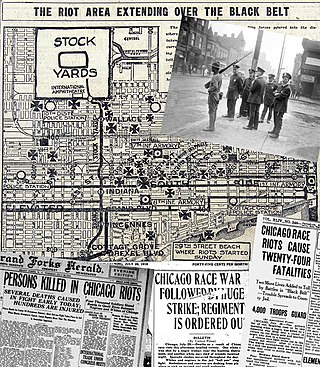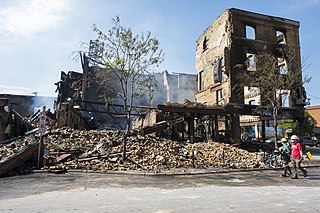
The 1967 Detroit riot, also known as the 12th Street Riot and the Detroit Uprising, was the bloodiest of the urban riots in the United States during the "long, hot summer of 1967". Composed mainly of confrontations between African American residents and the Detroit Police Department, it began in the early morning hours of Sunday July 23, 1967, in Detroit, Michigan.

Following the assassination of Martin Luther King Jr., a leading African-American civil rights activist, on April 4, 1968, Washington, D.C., experienced a four-day period of violent civil unrest and rioting. Part of the broader riots that affected at least 110 U.S. cities, those in Washington, D.C.—along with those in Chicago and in Baltimore—were among those with the greatest numbers of participants. President Lyndon B. Johnson called in the National Guard to the city on April 5, 1968, to assist the police department in quelling the unrest. Ultimately, 13 people were killed, with approximately 1,000 people injured and over 6,100 arrested.

The Glenville shootout was a gun battle that occurred on the night of July 23–24, 1968, in the Glenville section of Cleveland, Ohio, in the United States. Gunfire was exchanged for roughly four hours between the Cleveland Police Department and the Black Nationalists of New Libya, a Black Power group. The battle led to the death of three policemen, three suspects, and a bystander. At least 15 others were wounded.

The Chicago race riot of 1919 was a violent racial conflict between white Americans and black Americans that began on the South Side of Chicago, Illinois, on July 27 and ended on August 3, 1919. During the riot, 38 people died. Over the week, injuries attributed to the episodic confrontations stood at 537, two-thirds black and one-third white; and between 1,000 and 2,000 residents, most of them black, lost their homes. Due to its sustained violence and widespread economic impact, it is considered the worst of the scores of riots and civil disturbances across the United States during the "Red Summer" of 1919, so named because of its racial and labor violence. It was also one of the worst riots in the history of Illinois.
The 1968 Chicago riots, in the United States, were sparked in part by the assassination of Martin Luther King Jr. Rioting and looting followed, with people flooding out onto the streets of major cities, primarily in black urban areas. Over 100 major U.S. cities experienced disturbances, resulting in roughly $50 million in damage.

The long, hot summer of 1967 refers to a period of widespread racial unrest across major American cities during the summer of 1967, where over 150 riots erupted, primarily fueled by deep-seated frustrations regarding police brutality, poverty, and racial inequality within Black communities. This term highlights the intensity and widespread nature of the urban violence that summer.
From 1967 to 1973, an extended period of racial unrest occurred in the town of Cairo, Illinois. The city had long had racial tensions which boiled over after a black soldier was found hanged in his jail cell. Over the next several years, fire bombings, racially charged boycotts and shootouts were common place in Cairo, with 170 nights of gunfire reported in 1969 alone.

The King assassination riots, also known as the Holy Week Uprising, were a wave of civil disturbance which swept across the United States following the assassination of Martin Luther King Jr. on April 4, 1968. Some of the biggest riots took place in Washington, D.C., Baltimore, Chicago, and Kansas City.
The Wilmington Riot of 1968 occurred in Wilmington, Delaware, in April of that year following the assassination of Martin Luther King Jr. The riot did not cause any fatalities, though there were numerous injuries, arrests, and buildings burned. Despite the quick cessation of rioting, the governor refused to recall the Delaware Army National Guard and Delaware Air National Guard, leaving them in the city as an occupying force until the following year.
The 1968 New York City riot was a disturbance sparked by the assassination of Martin Luther King on April 4, 1968. Harlem, the largest African-American neighborhood in Manhattan was expected to erupt into looting and violence as it had done a year earlier, in which two dozen stores were either burglarized or burned and four people were killed. However, Mayor John Lindsay traveled into the heart of the area and stated that he regretted King’s wrongful death which led to the calming of residents. Numerous businesses were still looted and set afire in Harlem and Brooklyn, although these events were not widespread and paled in comparison to the riots in Washington D.C., Baltimore, and Chicago in which federal troops were needed to quell the disorders.
The 1964 Dixmoor race riot, also known as the Gin Bottle Riot, occurred between August 15 and 17 in Dixmoor, Illinois. After a woman accused of shoplifting a bottle of gin was wrestled to the ground by the owner of the liquor store and arrested, black residents took to the streets in anger. They picketed the liquor store, but then attacked it, looting it and burning various nearby buildings.
The Humboldt Park riot was the second major conflict between Puerto Ricans in Chicago and the Chicago Police Department. The riot began on June 4, 1977, and lasted a day and a half. Following the shooting deaths of two Puerto Rican men, locals battled Chicago police officers in Humboldt Park and in the streets surrounding. The riot led the community to hold the Division Street Puerto Rican Day Parade, which started in 1978.
Mass rioting and looting occurred in Chicago, Illinois in the immediate aftermath of the Chicago Bulls winning six NBA championships in the 1990s.
The 1967 Toledo riot was one of 159 race riots that swept cities in the United States during the "Long Hot Summer of 1967".

The term ghetto riots, also termed ghetto rebellions, race riots, or negro riots refers to a period of widespread urban unrest and riots across the United States in the mid-to-late 1960s, largely fueled by racial tensions and frustrations with ongoing discrimination, even after the passage of major Civil Rights legislation; highlighting the issues of racial inequality in Northern cities that were often overlooked in the earlier focus on the Southern states.
"When the looting starts, the shooting starts" is a phrase originally used by Walter E. Headley, the police chief of Miami, Florida, in response to an outbreak of violent crime during the 1967 Christmas holiday season. He accused "young hoodlums, from 15 to 21", of taking "advantage of the civil rights campaign" that was then sweeping the United States. Having ordered his officers to combat the violence with shotguns, he told the press that "we don't mind being accused of police brutality". The quote may have been borrowed from a 1963 comment from Birmingham, Alabama police chief Bull Connor. It was featured in Headley's 1968 obituary published by the Miami Herald.
The George Floyd riots in Chicago were a series of civil disturbances in 2020 in the city of Chicago, Illinois. Unrest in the city began as a response to the murder of George Floyd in police custody in Minneapolis on May 25, 2020. The demonstrations and riots, supporting justice for Floyd and protesting police brutality, occurred simultaneously with those of over 100 other cities in the United States. Chicago is among 12 major cities that declared curfews in order to prevent looting and vandalism. On May 31, Mayor Lori Lightfoot asked Illinois Governor J.B. Pritzker to send the Illinois National Guard to Chicago for the first time in the 52 years since the 1968 riots in Chicago. The economic damage caused by the disturbances exceeded $66 million.

False rumors of a police shooting resulted in rioting, arson, and looting in the U.S. city of Minneapolis from August 26–28, 2020. The events began as a reaction to the suicide of Eddie Sole Jr., a 38-year old black man who was being pursued by Minneapolis police officers for his alleged involvement in a homicide. At approximately 2 p.m. on August 26, Sole died after he shot himself in the head as officers approached to arrest him. False rumors quickly spread on social media that Minneapolis police officers had fatally shot Sole. To quell unrest, Minneapolis police released closed-circuit television surveillance footage that captured Sole's suicide, which was later confirmed by a Hennepin County Medical Examiner's autopsy report.

The aftermath of the George Floyd protests in Minneapolis–Saint Paul describes the result of civil disorder between May 26 and June 7, 2020, in the Twin Cities metropolitan area of the U.S. state of Minnesota. Protests began as a response to the murder of George Floyd, a 46-year-old African-American man on May 25, after Minneapolis police officer Derek Chauvin knelt on Floyd's neck for 9 minutes and 29 seconds as three other officers assisted during an arrest. The incident was captured on a bystander's video and it drew public outrage as video quickly circulated in the news media by the following day.
The 1967 New York City riot was one of many riots that occurred during the long, hot summer of 1967. The riot began after an off-duty police officer, Patrolman Anthony Cinquemani, while trying to break up a fight, shot and killed a Puerto Rican man named Renaldo Rodriquez who had a knife and lunged toward him.








